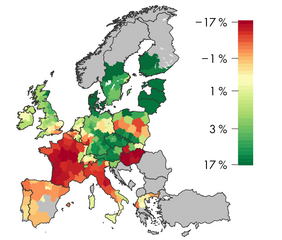Most European dairy farms rely upon on-farm produced forages as the primary source of nutrition for their cows. However, the productivity of forage crops depends on favourable weather conditions. In order to assess the possible consequences of climate change for the performance of farms in different climate zones, FiBL analysed a database containing the economic data of some 100,000 dairy farms from all over Europe. They linked the data to maps published by the Food and Agriculture Organization of the United Nations (FAO) that depict potential medium-term and long-term green forage and field crop yields.
More milk in the north, less in the south
The analysis shows that northern regions and mountainous areas such as the Alps could see forage yields increase by up to 12.5 per cent. That could be utilised to boost dairy production. However, it is important to take a critical look at whether these regions are suited to increased livestock densities. A more environmentally sound option would be to use less bought-in feed and, above all, less concentrate feed, especially in light of the increasing competition between feed and food for a growing world population. The changes are expected to be less pronounced in the Central and Western Atlantic zones. Here, a switch to more drought-tolerant forage crops – for example, to alfalfa instead of grass leys – could result in increased productivity. In Europe’s southern regions, forage yields and thus milk yields are expected to decrease. A switch to other forage crops might prove a successful adaptation strategy in these areas.
Grassland has the greatest level of stability
The analyses also show that pure grassland farms will be least affected, as grassland yields are relatively stable. Farmers who rely more on forage crops will be able to maintain or even increase the current level of productivity in practically all regions if they optimise their choice of forage crop for the climate. However, these overall rather positive results only apply if the systems remain relatively stable. There is also a possibility that increased extreme weather events and heat waves could negate any positive effects of a warmer climate.
Further information
Contact
Simon Moakes
Link
fibl.org: Activity report (4.4 MB)




